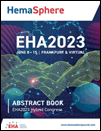P444: SINGLE CELL RNASEQ UNCOVERING THE ROLE OF A LEUKEMIC DRIVER GENE FUSION CBFΒ::MYH11 IN THE LEUKEMIC–NICHE SIGNALING
Background: Leukemias constitute the most frequent pediatric cancers. Acute myeloid leukemias (AMLs) are often characterised by aberrant fusion proteins that initiate and drive the disease. Fusion proteins like RUNX1::RUNX1T1, CBFβ::MYH11 or KMT2A corrupt transcriptional networks leading to impaired cell differentiation and enhanced malignant proliferation. While the intrinsic effects of fusion genes on the leukemic cell are subject of intensive research, much less is known about how fusion proteins affect the communication within its microenvironment. For prolonged ex vivo expansion of primary AML cells, we have established a co-culture system employing human bone marrow-derived mesenchymal stromal cells (MSCs). In combination with fusion protein-specific agents such as the CBFβ::MYH11-specific inhibitor AI-10-49, this system provides an experimentally accessible platform to interrogate the role of leukemic fusion proteins in leukemic niche interactions.
Aims: 1. Examine the dependence of primary inv(16)/t(16;16) AML material on CBFβ::MYH11 function.
2. Investigate the intrinsic consequences of inhibiting CBFβ::MYH11 fusion protein function in primary inv(16)/t(16;16) AML material.
3. Study the role of the CBFβ::MYH11 fusion protein in the communication and interaction between AML and bone marrow niche cells in an ex vivo setting.
Methods: We cultured and expanded inv(16) and t(16;16) pediatric bone marrow aspirates on MSCs. Perturbation experiments were performed using AI-10-49, an inhibitor with high specificity for the fusion. We monitored drug response by cell counting, and surface expression of myeloid lineage differentiation by flow cytometry. Cocultures treated for 4 days with 750 nM AI-10-49 were subjected to single cell RNAseq (scRNAseq; 10X Genomics platform). The reads were aligned to the reference genome+transcriptome and counted with CellRanger software. Downstream analysis was done in R, mainly using the Seurat package. Inference of ligand-receptor signaling and downstream transcriptional networks was performed with the NicheNetR package.
Results: Treatment of CBFβ::MYH11-positive primary AML cells with AI-10-49 impaired proliferation and viability with IC50 values of 600 nM. Loss of CBFβ::MYH11 function was associated with a decrease of CD34 surface. scRNA-seq showed increased monocyte-like cell populations and a loss of gene expression linked to self-renewal. These data show that leukemic proliferation, viability and self-renewal of primary human AML cells are strictly dependent on CBFβ::MYH11.
While AI-10-49 treatment hardly affected MSC gene expression in single culture, CBFβ::MYH11 inhibition in co-culture yielded a substantial shift of MSCs in UMAP suggesting that disturbed fusion protein function is communicated to the MSC compartment. Inference of ligand-receptor signaling and downstream transcriptional networks, combined with gene set enrichment analysis (GSEA), revealed a downregulation of TGFβ1–TGFβR1 signaling axis and increased TNF and IL1 signaling between AML cells and MSCs upon AI-10-49 administration. These data suggest a remodeling of the extracellular matrix and a shift from an anti- to a more pro-inflammatory environment.
Conclusion: Our results illustrate a strong dependency of inv(16)/t(16;16) primary AML cells on their fusion driver CBFβ::MYH11 in an ex vivo setting and support of an anti-inflammatory microenvironment potentially helping inv(16)/t(16;16) AML cells evade the immune surveillance. Inhibition of CBFβ::MYH11 in inv(16)/t(16;16) AML, therefore, could be a promising treatment option.
Keywords: Signaling, Inv(16), Bone marrow niche




